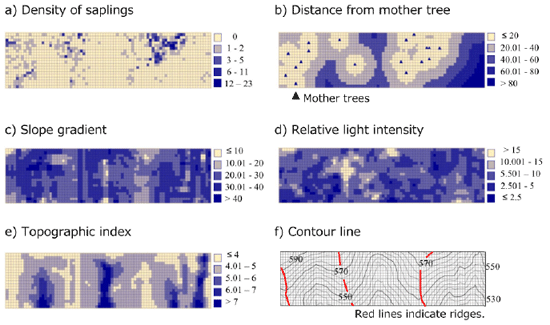Guideline for selective logging techniques for Shorea curtisii, a dominant species of hill dipterocarp forests in Peninsular Malaysia
Description
In Peninsular Malaysia, active logging sites and deforestation are recently spreading into the hills and mountain areas, and it is expected that the next logging operation will only be possible after 40 to 60 years with the natural recovery of forests. However, some degraded hill forests can be observed after selective logging in the peninsula. Improvement of selective logging techniques is required to promote the natural process of forest recovery after logging and to achieve sustainable use of timber resources. The limiting factors for regeneration and distribution of dominant tree species are essential information to understand the process of forest establishment. The aim of this research is to determine the factors affecting the spatial distribution of saplings of Shorea curtisii (Dipterocarpaceae), a dominant species in lower hill dipterocarp forest, and to suggest a new guideline for selective logging.
Saplings of Shorea curtisii (>30 cm in height and <5 cm in diameter at breast height) show aggregated distribution on ridged sites and occur exclusively within a 40 m distance from mother trees which remained at the last selective logging area in the Semangkok study site (Fig. 1). The Markov Chain Monte Carlo method with the Bayesian approach illustrates that the number of S. curtisii saplings per 5 m-grid is explained by three parameters, i.e. distance from mother trees (m), relative light intensity (%), and topographic index (Fig. 1 & Table 1). Here, topographic index represents the concavity and convexity of the ground surface, and is related to soil humidity. Within the above three parameters, distance from mother trees and topographic index have powerful negative effects (Table 1); that is, the sapling density is higher on sites closer to mother trees and more convex such as in areas which can be found in ridges. It is necessary to retain mother trees of S. curtisii with spatial intervals of less than 50 m to obtain a widespread sufficient number of saplings in a logged forest compartment. Trees of S. curtisii standing on slope and valley parts, where a few number of S. curtisii can be found, should be conserved. The current manner of operation that retains mother trees in patches would result in skewed distribution and species composition in the next generation forest.
Careful operations are required for selection of cutting trees, felling direction and design of forest roads in order to minimize the disturbance on the forest floor by selective logging with certain intervals between mother trees. A simple manual for logging operators is needed to expand use of the new criterion.
Figure, table
-
Fig. 1.
a) Density of S. curtisii saplings (/25m2), b) Distance from mother trees (m), c) Slope gradient (degree), d) Relative light intensity on forest floor (%), and e) Topographic index representing surface concavity and convexity in the Semangkok logged-forest plot of 4 hectares. Grid size is 5m by 5m. -
Table 1 Parameters affecting spatial distribution of S. curtisii saplings in the Semangkok logged-forest plot.
- Affiliation
-
Japan International Research Center for Agricultural Sciences Forestry Division
- Classification
-
Administration B
- Term of research
-
FY2006~2010
- Responsible researcher
-
Yagihashi Tsutomu ( Forestry and Forest Products Research Institute )
OTANI Tatsuya ( Forestry Division )
KAKEN Researcher No.: 80353613Tani Naoki ( Forestry Division )
KAKEN Researcher No.: 90343798 - ほか
- Publication, etc.
-
Yagihashi et al. (2010) Habitats suitable for the establishment of Shorea curtisii seedlings in a hill forest in Peninsular Malaysia. J. Trop. Ecol. 26:551-554.
- Japanese PDF


